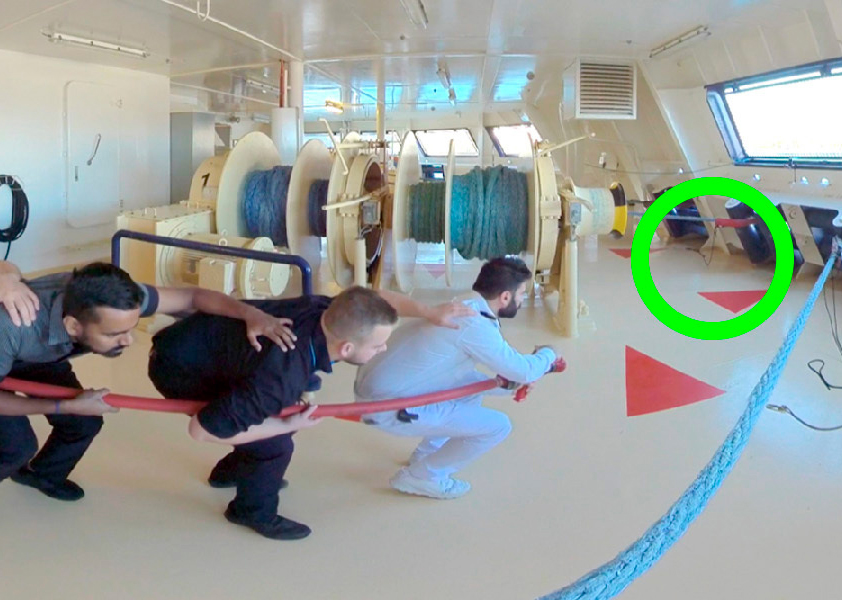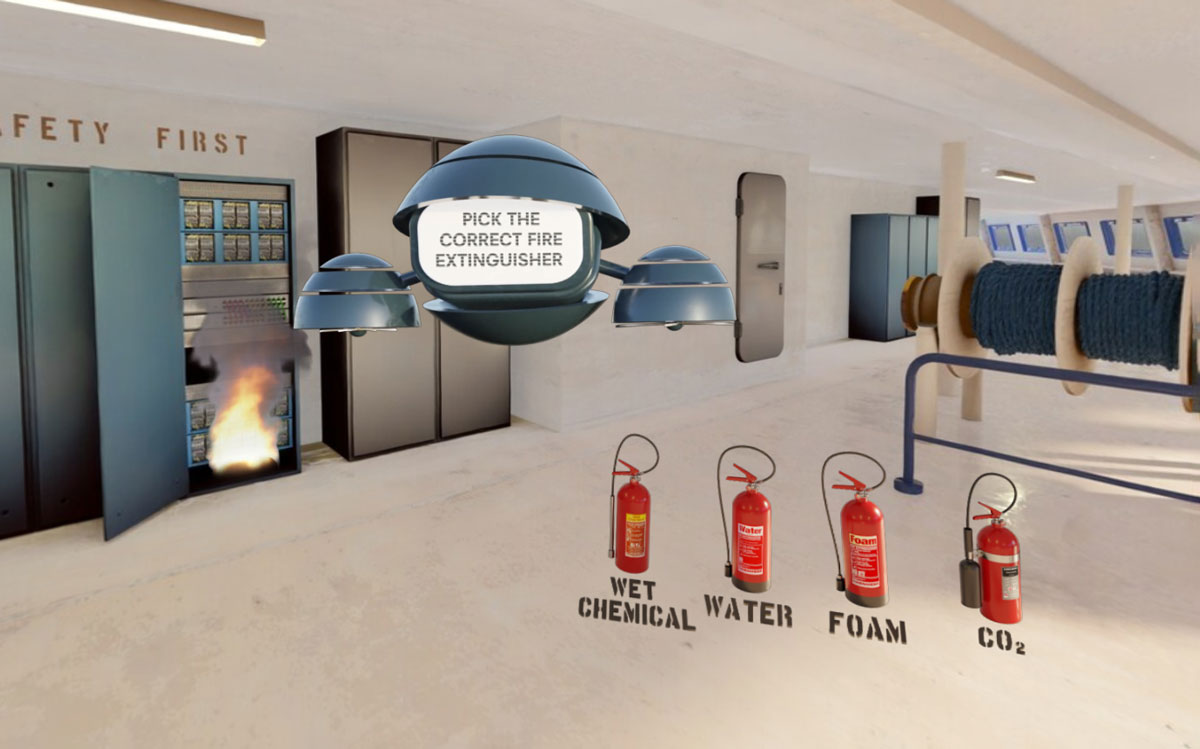Table of Contents
Introduction
Explore how investing in VR technology for standardized training can drive substantial ROI. Read real-world examples and EXP360’s cost-saving solutions.
Virtual Reality (VR) has rapidly emerged as a transformative technology, influencing diverse sectors from gaming to education, healthcare, and especially, training. By providing immersive, interactive experiences, VR offers an entirely new approach to learning and development, making it a compelling tool for employee training programs.
However, a significant issue faced by many businesses, particularly in industries such as aviation, manufacturing, and the cruise line sector, is the substantial recurring cost of mandatory, standardized training. Employees are required to undergo these training programs regularly to maintain the business’s legal status, which often entails high expenditures for instructors, facilities, travel, accommodation, and lost work time. Hence, there’s a pressing need for a solution that can provide high-quality, standardized training but in a cost-effective manner. Could VR be the answer? This blog post aims to explore this question and investigate the potential Return on Investment (ROI) from adopting VR technologies for standardized training.
The Costs of Standardized Training
Standardized training has been an indispensable aspect of numerous industries to ensure quality control, safety standards, and compliance with regulatory bodies. However, these training programs, particularly when done in person, come with substantial costs.
One of the significant expenses is the instructor fees. Hiring qualified professionals to conduct training programs isn’t cheap, and these costs can escalate quickly for larger teams or extensive training programs.
Then come the venue costs. Unless a business has an on-site facility large enough to conduct the training, they must rent out external locations. Depending on the nature of the training, these venues must often meet certain specifications, which can increase the rental cost.
Travel and accommodation are another major expense. If the training is conducted at an off-site location, companies have to foot the bill for employees’ transport. In some cases, overnight accommodation may also be necessary, further adding to the cost.
Another hidden cost is the time employees spend away from work, which could otherwise be spent on productive tasks contributing to the bottom line. When employees are away for training, it often leads to reduced productivity, delayed projects, and potential overtime payments for other staff covering shifts.
Examples
Let’s look at some examples.
In the cruise line industry, crew members must undergo regular safety training to comply with international regulations. This often involves physical drills, equipment familiarization, and emergency simulations. The logistics of gathering hundreds of crew members in one location, providing instructors, and compensating for lost work time can be monumental.

The aviation industry faces similar challenges. Mandatory training for cabin crew, ground staff, and maintenance teams are required for safety, customer service, and technical skills. Here, the costs of training are even higher due to the need for specialized equipment and facilities.
Similarly, in the manufacturing sector, employees need to be regularly trained on equipment operation, safety protocols, quality control, and more. Due to the nature of the work, the opportunity cost of having employees away from the production line for training can be substantial.
Given these considerable costs, it’s clear that traditional in-person standardized training is a significant expense for businesses. However, by leveraging VR technology, these costs could be significantly reduced, resulting in substantial savings.
VR Training as a Cost-effective Solution
As businesses grapple with the costs and logistics of traditional standardized training, Virtual Reality (VR) presents a cost-effective and efficient alternative.
By replacing or supplementing in-person training with VR, businesses can significantly reduce many of the costs associated with traditional methods.
For instance, the instructor fees can be curtailed as VR training often requires a one-time setup and can be repeatedly used without the need for a physical instructor. This can be particularly beneficial for standardized training that does not require personalization or direct human interaction.
Venue costs can also be eliminated or reduced as VR training can be carried out on-site or even remotely. This flexibility not only reduces direct costs but also mitigates the disruption to routine operations.
The travel and accommodation expenses associated with off-site training can be virtually eliminated. VR training can be conducted wherever the employees are, removing the need for costly travel or accommodation arrangements.
Most importantly, VR training can minimize productivity loss associated with training. As VR training is flexible and can be scheduled at suitable times, employees can efficiently manage their work and training schedules.
Beyond these immediate cost savings, there’s an added benefit: the ability to use licensed, audited virtual training content from a library. Companies no longer have to invest time and resources in developing their training content. Instead, they can access a range of pre-designed, industry-specific training programs that meet their needs.

Benefits of VR Training Beyond Cost Savings
While the cost savings associated with VR training are substantial, they’re only part of the picture when considering the return on investment. VR training offers several additional benefits that can significantly enhance the effectiveness of training programs and contribute to the overall ROI.
One of the most significant advantages of VR training is the increased retention of information. Various studies have shown that learning in an immersive VR environment can significantly enhance memory retention and understanding. This improved learning efficiency translates into better job performance, fewer mistakes, and, ultimately, increased productivity – all of which contribute to a company’s bottom line.
Flexibility in scheduling is another significant benefit. Traditional, in-person training sessions need to be scheduled at specific times, often causing disruptions to normal work routines. With VR, training can be scheduled flexibly around other commitments, resulting in less disruption and more efficient use of time.
Finally, VR training allows businesses to replicate real-world scenarios without the associated risks or costs. This is particularly beneficial in industries like manufacturing, aviation, and healthcare, where mistakes can have serious consequences. With VR, employees can practice and learn in a safe, controlled environment before they apply their skills in the real world. This can significantly reduce the risk of accidents or errors, resulting in safer workplaces and potential savings on insurance and compensation costs.
In conclusion, while the direct cost savings of VR training are easy to quantify, the additional benefits provide an even greater return on investment. By enhancing learning outcomes, providing greater flexibility, and reducing risks, VR training goes beyond mere cost savings to deliver substantial value to businesses.
Case Studies and Real-world Examples
To underline the practical benefits and diverse applications of VR training, let’s consider several real-world examples where this technology has been effectively utilized.
Fire Fighting Demo
First, let’s examine the realm of fire safety. Traditional fire fighting training can be logistically challenging and hazardous. However, with VR, trainees can learn to interactively select the correct fire extinguisher and practice extinguishing fires in a risk-free, virtual environment.
This not only saves the cost of materials and ensures safety but also allows for unlimited practice runs.

Security Training
Security training at airports and ships is another area where VR shines. Staff need comprehensive awareness training to stay alert to potential security threats.
VR can mimic these scenarios closely, offering an immersive learning experience that heightens the trainee’s observational skills.

Personal Protection Equipment (PPE) training
The same principles apply in the realm of personal protection equipment (PPE) training. In various industries, workers need to learn how to select the correct PPE for different scenarios. Through VR, they can gain this knowledge interactively, which enhances information retention.

F&B Service Awareness Training
Consider a hospitality scenario. Restaurant staff often need extensive training to ensure top-notch service. VR can provide this in the form of Restaurant Awareness Training, allowing staff to experience and manage various service scenarios, improving their skills, and enhancing customer satisfaction.

Each of these examples showcases the successful implementation of VR training and the associated cost savings and improved outcomes. They illustrate why companies like EXP360 are leading the way in providing efficient, cost-effective solutions for diverse training needs.
Calculating ROI for Your VR Training Program
Understanding the return on your investment in VR training can help inform your decision-making process. To calculate the ROI, consider both the costs saved and the additional benefits gained through the use of VR.
Start by quantifying the costs associated with traditional training methods that VR would replace – instructor fees, venue costs, travel and accommodation, and productivity loss during training. Then, subtract the cost of implementing and maintaining your VR training program. This difference will give you an indication of the cost savings.
Next, consider the additional benefits. These can be harder to quantify but are no less important. For example, measure improvements in learning outcomes through test scores or performance metrics. Consider the reduction in safety incidents or the increase in customer satisfaction scores if they’re relevant to your training.
One of the key features of the EXP360 platform that can further enhance your ROI is its ability to repurpose content for different uses. The content you use for training can also be used for marketing or HR purposes, providing additional value. It means your initial investment in creating or purchasing VR content can be shared across multiple departments and used in various scenarios.
Therefore, while calculating ROI, do not forget to factor in the savings made by utilizing the same VR content across multiple departments or training programs. With the right approach, the ROI from your VR training program could be significantly higher than traditional training methods.

Conclusion
In conclusion, investing in Virtual Reality for standardized business training presents an opportunity for significant cost savings and improved training outcomes. We have discussed how VR can reduce or eliminate many of the costs associated with traditional in-person training. We also explored the added benefits that VR brings to the table, including higher information retention rates, scheduling flexibility, and the ability to safely replicate real-world situations.
We’ve considered case studies where VR training has been implemented successfully and provided a guide on how to calculate potential ROI from a VR training program, focusing on cost savings and improved outcomes. Notably, the use of EXP360’s platform brings an extra layer of cost-effectiveness through its feature of multi-use content, which can be used across different departments and scenarios.
In light of these advantages, businesses should strongly consider VR as a viable solution to their mandatory, standardized training needs. A thorough ROI analysis can be the first step in this direction, highlighting potential savings and improved effectiveness of training programs. It’s time to embrace the future of training with VR technology and realize the potential ROI it promises.
Photo by Zbynek Burival on Unsplash



